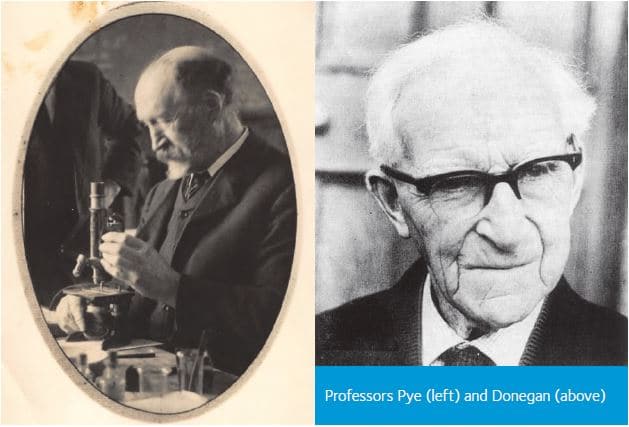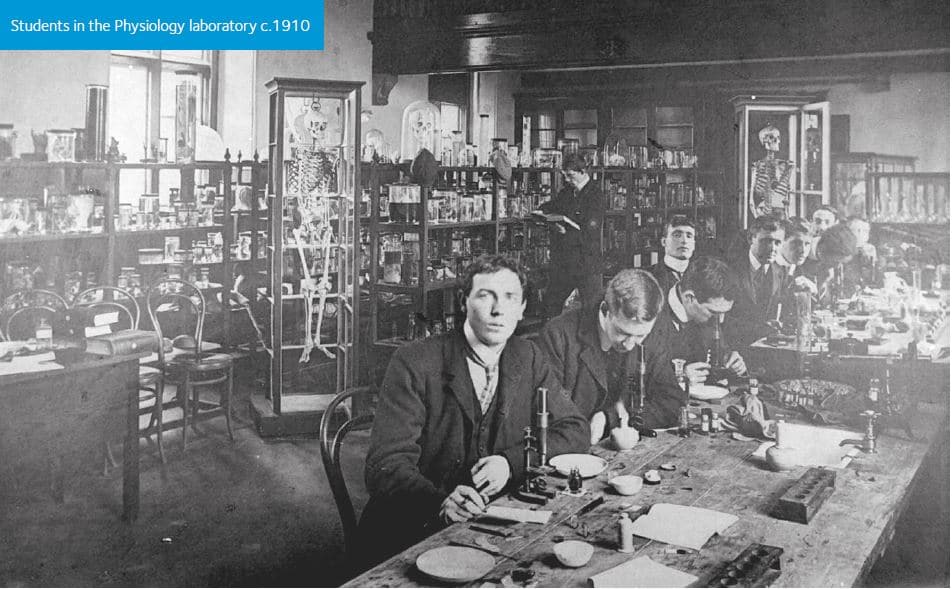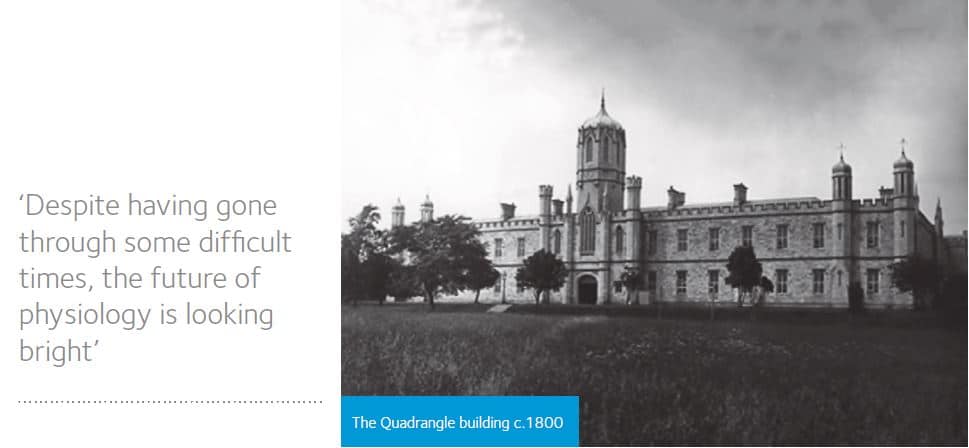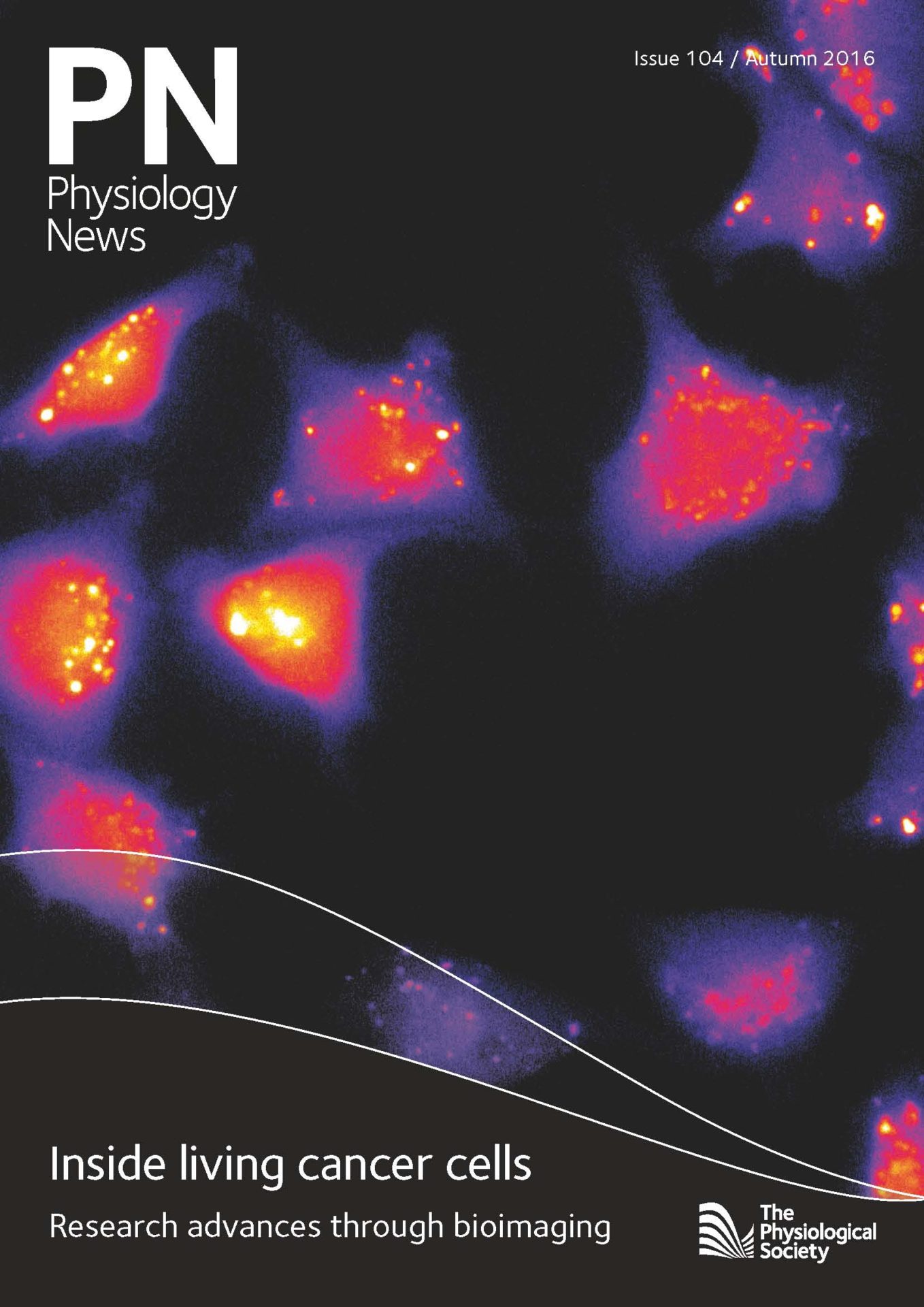
Physiology News Magazine
Physiology at NUI Galway
News and Views
Physiology at NUI Galway
News and Views
Michael Kane
Retired, former Pre-clinical Vice-Dean and Head of Physiology, NUI Galway
Karen Doyle
Lecturer, Department of Physiology, NUI Galway
Antony Wheatley
Professor of Physiology, School of Medicine, NUI Galway
https://doi.org/10.36866/pn.104.12
The Early Years
The National University of Ireland Galway was established under the Colleges (Ireland) Act 1845. The University was originally known as Queen’s College Galway and was established, along with Queen’s College Cork and Queen’s College Belfast to offer non-denominational university education to the community. The Queens’s College, Galway was later renamed University College Galway (1908) and later still National University of Ireland Galway (1997).
Queen’s College Galway opened its door in October 1849 and students entered the Faculties of Arts (Literacy & Science divisions), Law and Medicine. Of the five professors in the Faculty of Medicine, Professor Charles Croker King was appointed Professor of Anatomy & Physiology, a post he held until 1863. He was succeeded by John Cleland who held the position until 1877 when he moved to the University of Glasgow to take up the position of Regius Professor of Anatomy, a post he held until 1909. Under Croker King and Cleland, the reputation of anatomy and physiology developed and attracted many students to Galway. Professor Cleland was a renowned researcher and during his time in Galway he edited Quain’s Anatomy (1867 edition) and was elected to a Fellowship of the Royal Society.
In 1877, Joseph P Pye was appointed to the combined Chair of Anatomy & Physiology, a post he held until his death in 1920. At this stage, independent chairs of Anatomy and Physiology were established and Joseph F Donegan became Professor of Physiology and remained in post untill he retired in 1963. Thus two professors, Pye and Donegan, served physiology in Galway for 86 years. In his early career, Donegan had worked in the Physiology Laboratory under Professor Joseph Barcroft in Cambridge and also in the Institute of Physiology, University College, London, with WM Bayliss and EH Starling. He also worked in Berlin during two summer vacations and a sabbatical leave with two Nobel Prize winners, Otto Warburg and Hans Krebs. As Professor of Physiology, he taught, almost entirely on his own, not just physiology but also histology and physiological chemistry to medical students. Donegan was known to expect high standards from his students. A story told about him, possibly apocryphal but probably factual, illustrates this trait.


One particular class of medical students (class size about 40-50) was very ‘big into’ rugby but not so ‘big into’ their studies of physiology and held the opinion ‘He can’t fail the lot of us!’ Big mistake! A large majority of the students were failed and had to repeat the exam. He served on the Council of The Physiological Society from 1962 to 1966, and in 1976 he was honoured by The Society with the conferral of Honorary Membership.
The long service of these two professors in physiology was paralleled by the continuous service of two remarkable technicians, Thomas and Murt Hynes, father and son, for 80+years between about 1910 and 1995. Both were well-known long distance runners. Thomas Hynes had a road in Galway named after him. He represented Ireland in international cross-country races and marathons; in 1909, he was the first winner of a marathon organised in Ireland. He also fought in the Irish War of Independence 1919-1921. In a submission to the Irish Bureau of Military History, he recounted how he had been Quartermaster of the Galway Brigade of the Old IRA and, while on the run from the Black and Tans, often hid out at night in the Physiology Department in the UCG Quadrangle. His son, Murt, who succeeded him as chief technician, was a highly respected man of great integrity and scrupulous fairness. In athletics, he was a father figure in Irish long distance running. Making use of his athletic contacts, he pioneered the use of physiological testing on leading Irish athletes at UCG in the late 1960s early 1970s.
Physiology at NUI Galway: 1960–2000
After Professor Donegan’s retirement in 1963, Dr JK (Kieran) Burns was appointed Professor of Physiology. Professor Burns was an unconventional physiologist with an interest in the interaction of science and religion. His individual approach to research was not always well received by the Members of The Physiological Society at its annual meetings. He retired from the University in 1991.
In the early 1960s, Burns was joined by two academic colleagues, firstly Dr Dom Colbert, the author of Fundamentals of Clinical Physiology (Prentice Hall, 1992) and MCQs in Basic and Clinical Physiology (OUP 1996). Dr Colbert also had a longstanding interest in travel and tropical medicine. In 1977, he founded the Voluntary Service Abroad society and worked extensively in Africa, the Far East and the Caribbean in a voluntary capacity. He received many honours including an honorary fellowship from COSECSA (College of Surgeons of East Southern and Central Africa) in 2013. Dr Daniel O’Donovan also joined the Department in the mid-1960s. He was a renal physiologist who had gained his PhD at the University of Rochester working with Professor RF Pitts. Much of his work was concerned with acid-base balance and the kidney particularly the role of glutamine metabolism. He was promoted to Associate Professor in 1976 and was awarded the Conway Medal for Research from the Royal Academy of Medicine in Ireland in 1984.
He retired in 1997.
In 1976, Dr Michael Kane, a reproductive physiologist, was appointed lecturer and went on to be promoted to Associate Professor (1991) and appointed to Professor of Physiology in 1995, 4 years after Professor Burns retirement. His two major areas of research interest were preimplantation embryo growth and ovarian follicle development. He was awarded the Conway Medal in 1990, a DSc from the National University of Ireland in 2005, elected a member of the Royal Irish Academy in 2007, and awarded the Marshall Medal from the Society for Reproduction and Fertility in the UK 2016. At the time of the start of Professor Kane’s tenure as Head of Physiology in 1995, teaching in physiology was almost entirely limited to medical students and laboratory teaching facilities were in a very poor state; there was an almost total absence of modern student laboratory equipment and smoke drums were still being extensively used in student laboratory classes. A major priority of Kane’s tenure as Head of Physiology was the improvement of physiology teaching, especially laboratory teaching. As Pre-clinical Vice-Dean, Professor Kane oversaw the re-organisation of the first two years of the medical course so that the former discipline-based teaching was replaced with integrated module based teaching by the preclinical departments of Physiology, Anatomy, Biochemistry and Pharmacology.

NUIG Physiology – the years of expansion
In decade from the late 1990s into the 21st century, NUIG went through a transition from being a small institution on the west coast of Ireland into a modern medium-sized university (±17,000 students) catering for both local and international students. In addition, the College of Medicine, Nursing and Health Sciences was an established lead in teaching and research in the Institution. The expansion of the medical programme, the arrival of increasing numbers of health science students and the increasing popularity of physiology among Science students led to an explosion in the volume of teaching Physiology staff had to carry. Much of the teaching load in this time was carried by four enthusiastic young lecturers, Ailish Hynes (endocrinology), Leo Quinlan (epithelial physiology/electrophysiology), Karen Doyle (neuroscience) and later Michelle Roche (neuroscience), and helped by an excellent technician, Barbara Coen, who had previously worked in the Physiology Department at Charing Cross Hospital. The research of the Department benefited from the fact that, in addition to local Irish funding over a number of years in the 1990s and early 2000s, Professor Kane and other Departmental members were able to obtain considerable research funding via a number of European Framework programmes. However, the huge teaching load of the Department was a serious hindrance to research at this time and the work of the Department was inhibited
by a long failure to provide alternative facilities to its cramped quarters in the old University Quadrangle.
In 2009, Antony Wheatley (liver and cardiovascular physiologist) was appointed Professor of Physiology, following the retirement of Professor Kane in 2006 and there followed additional appointments, Louise Horrigan (immunology), Amir Shafat (human physiology), Karl McCullagh (muscle), Beth Mallard (liver and gastrointestinal physiology) and Brendan Higgins (lung injury). For further information about our research programmes, please consult our departmental webpage (www.nuigalway.ie/physiology/).
The future
Despite having gone through some difficult times, the future for physiology is looking bright. Firstly, we are still an autonomous department within the School of Medicine, with control over our teaching and research activities. Secondly, after years of being poorly resourced (our departmental administration is still in the University Quadrangle; I guess we have been there since 1847) we are on the threshold of moving into an 8000m2 new teaching/research building along with the Departments of Anatomy and Pharmacology & Therapeutics. It is anticipated that the new building will open its doors before the end of 2016. The new building will house the University Bioimaging Centre, an animal behaviour suite and more than 1000m2 of additional research laboratory space. The future of Physiology at NUI Galway is looking bright.
